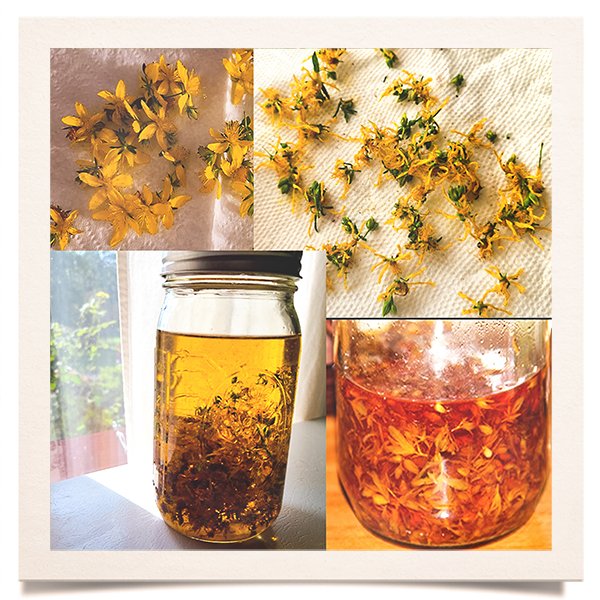St. John’s Wort (Hypericum perforatum)
We at Nature’s Common Scents use the rich, red oil that results from the dainty yellow flowers of St. John’s Wort in some of our skin healing recipes. As with other plants we grow and use in our products, we are very pleased to be able to give our customers the benefits from not only wonderful plants, but plants we grow ourselves. Truthfully that isn’t possible with all herbs we use because of the quantities needed, but with St. John’s Wort and a few others, what ends up in your product has been harvested by our own hands!
The plant’s common name, St. John’s Wort is named for the Apostle John because it blooms around the time of the birthday of the saint, author of the Book of Revelation. If you want to grow it, be sure to use the botanical name when ordering it.
This morning I was harvesting the beautiful, dainty bright yellow flowers. The bees were joining me and I was careful to let them gather the pollen off each blossom before I took it. Harvesting the flowers requires patience, as you have to grasp the flimsy flower stalk and hold it so that when you pinch off the flower you don’t pull off the buds around it.
One of the unusual aspects of St. John’s Wort flowers is their ability to stain your fingers and fingernails red! The red color comes from an oil that is in the glands of the petals. If you’ve ever worked with blueberries, you might have found your fingers and nails similarly stained. And you’ll know that it’s pretty hard to remove.
The leaves of the plant also have oil glands, and when you hold the leaf to the light, they look like very tiny transparent dots.
St. John’s Wort has been used since the time of Ancient Greece and Rome to heal wounds, sores, burns, bruises, sprains, inflammation and nerve pain. This is why we use it for skin issues. It was also used to help insomnia, epilepsy and “madness.” Around the Middle Ages, it was used as treatment for heart issues, jaundice, urinary problems, dysentery, bleeding, hysteria, and depression.
But we focus on topical healing, confident this historical plant with the bright, dainty flowers has the ability to help your skin improve.
How we make the oil:
The flowers need to be wilted, but not completely dry. I put each day’s harvest on a clean paper towel for the day. The pictures below show them fresh, then slightly wilted.
At that point I put them into the jar of olive oil. If you are fortunate enough to get lots of flowers all at once, fill the jar loosely and then cover the flowers with oil. Place the jar in a sunny window and shake it daily for several weeks. In two to three weeks you will see the yellow oil turn red.


